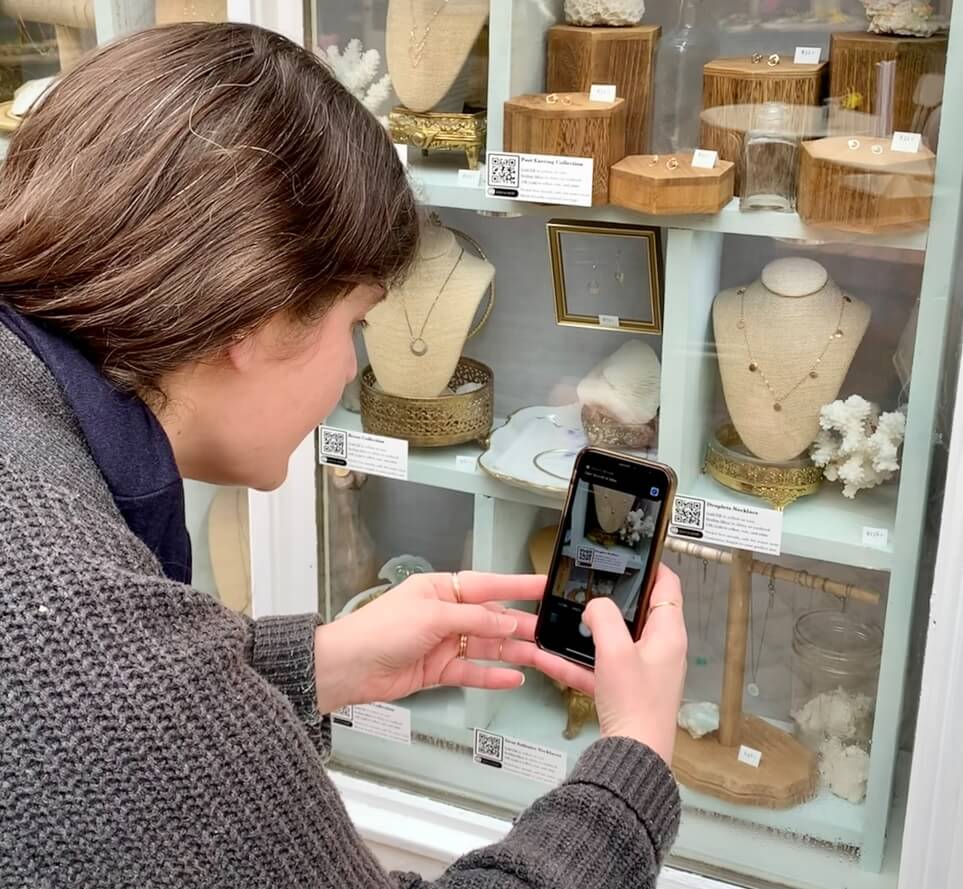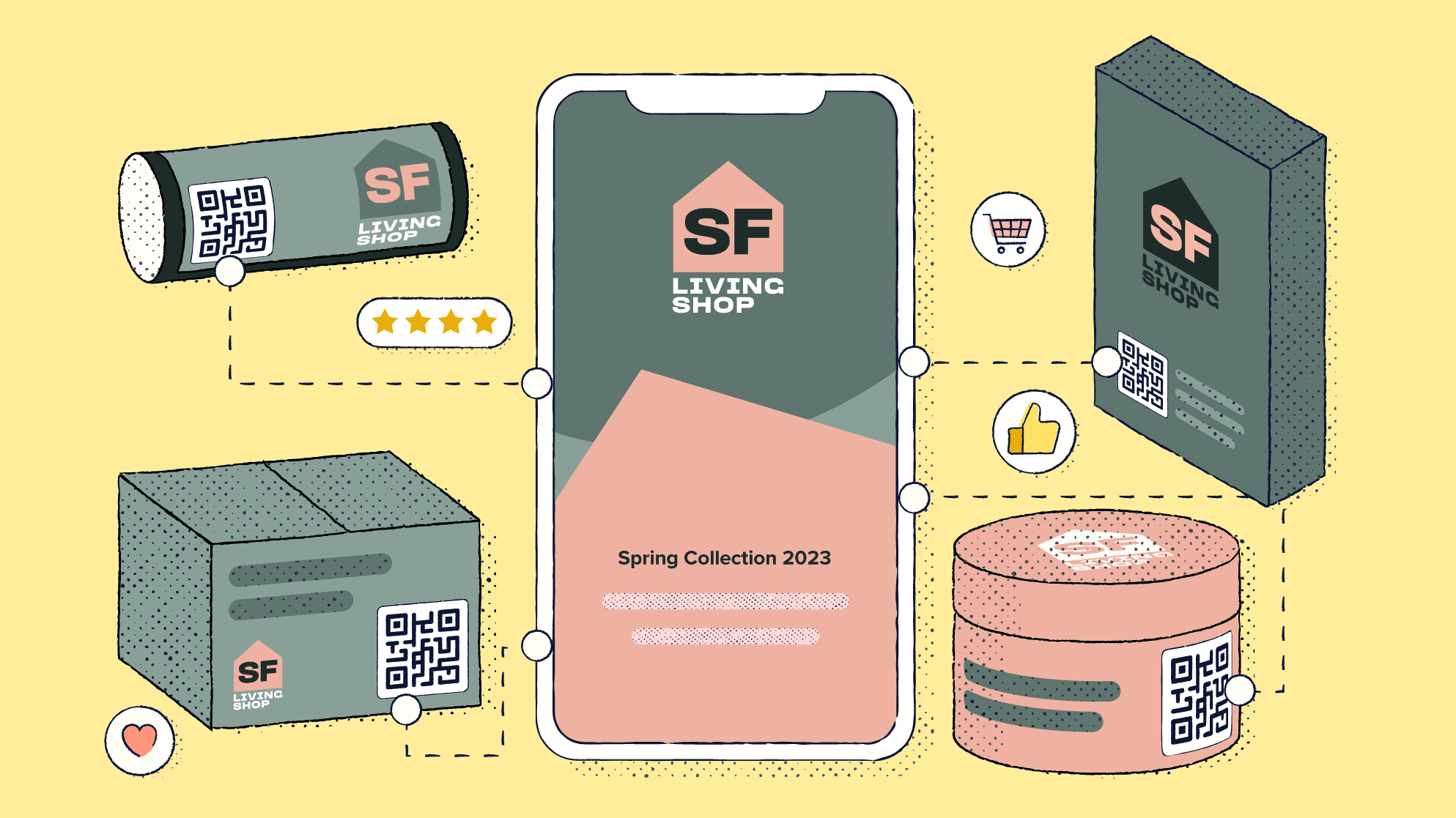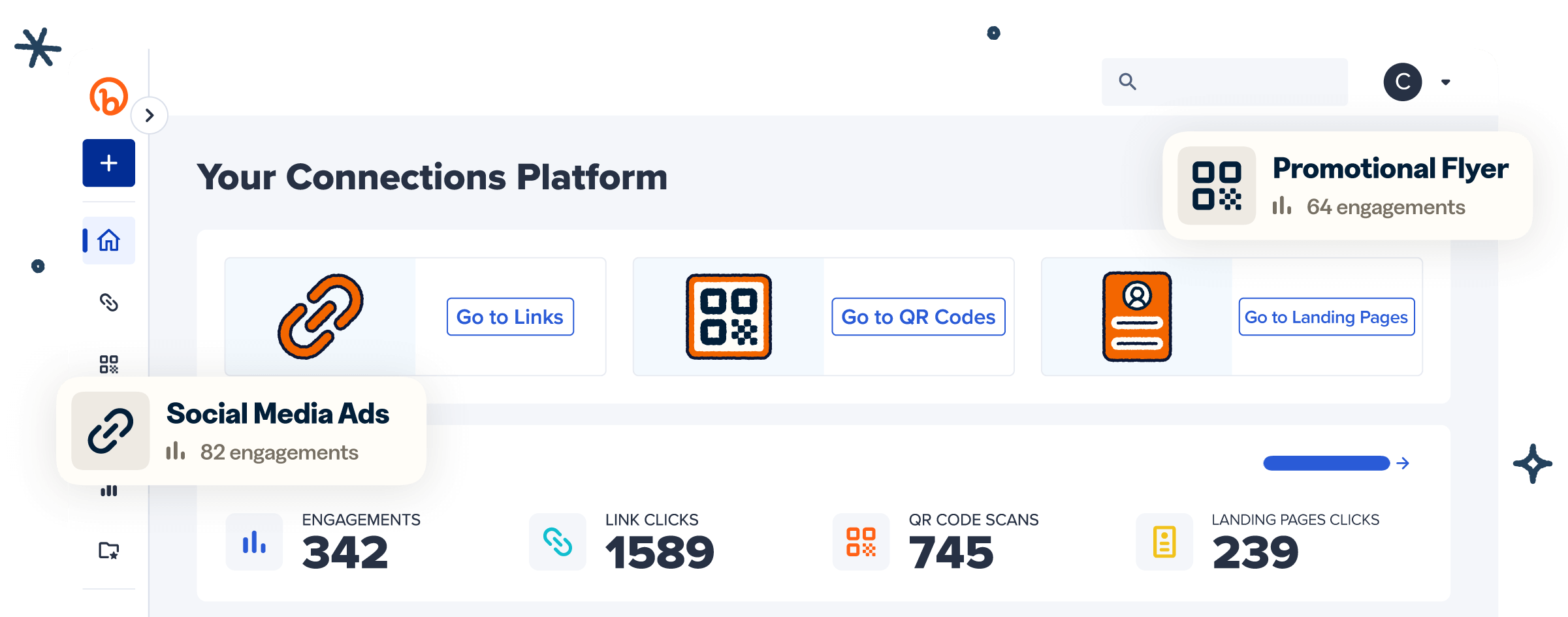Thirty years after their invention, QR Code usage has surged. As the retail marketing landscape evolves, savvy retailers offer their customers in-store experiences with the convenience, engagement, and sense of control they enjoy online.
QR Codes in online and offline retail efforts attract, retain, and inform prospects and customers. Smartphone or tablet users can connect to personalized, touch-free web experiences. It’s as simple as pointing a digital camera at a QR Code.
Customers can then view customized landing pages, access special offers or promotions, and make instant purchases with one click. Discover below some of the most innovative, inspirational use cases, and examples of QR Codes in retail.
The benefits of QR Codes for retailers
QR Codes benefit retail marketers in many ways. They are a low-cost, versatile tool, and QR Codes are an omnichannel promotional approach that is easy to deploy and track. Another plus: You can make your brand stand out with customization options.
Bazaarvoice, Inc.’s 2022 “The State of Retail Report” revealed that consumers want in-store tech that provides user-generated content—QR Codes deliver precisely that. For the in-store experience, 36% said they wanted to see customers’ photos, videos, and reviews displayed virtually. A further 34% said they want QR Codes they can scan to read reviews. Thirty-three percent would like live and up-to-date star ratings based on customer feedback.
Let’s look at just a few of the many benefits of retail QR Codes.
Versatility
QR Codes provide many marketing possibilities, such as making Bitcoin payments, offering loyalty discounts, linking to restaurant menus, and analyzing customer buying patterns. Use them on product packaging, posters, brochures, or in-app promotions to boost retail purchases.
Plus, integrating QR Codes into your marketing campaigns is cost-effective—you can go the “do-it-yourself” route, but it is easy to make QR Codes without a significant monetary investment.
Brand customization
QR Code usage grew by 41% in the first half of 2023. Retailers can create unique designs through customization feature options such as patterns, colors, call-to-action (CTA) frames, and logos to represent their brand.
A custom QR Code increases brand recognition, distinguishes items from competitors, and reinforces trust and reliability. Since QR Code scanning is now a native feature on iOS and Android devices, customers can access your brand’s marketing content without using a third-party scanning app.
Easy implementation
Simply download QR Codes for online access or print the code on marketing vehicles like billboards, ads, or other media. Since almost every smartphone has a camera, scanning is as simple as aiming the device at the QR Code.
You can include QR Code CTAs encouraging customers to scan the codes and link them to your latest promotions, product information, or social media pages. CTAs are also valuable for collecting customer feedback or data for future marketing strategies.
Tracking and analysis
You can track QR Codes (in a tool like Bitly Analytics) and export them to other dashboards or analytics tools like Google Analytics for an ever deeper dive. Collect the number of scans and unique visitors, the device used to scan, city-level location, and time of day, depending on the tool you use.
From there, you can analyze the data to see which campaigns or promotions were most successful, which locations had the most scans, and which devices people used most frequently. This information can help inform future marketing strategies and improve customer targeting.
Omnichannel applications
You can use QR Codes for omnichannel marketing campaigns spanning multiple platforms, combining online marketing with media like TV ads, outdoor ads, and print and promotional swag. Customers can scan at home, in-store, or on the go.
But there is a caveat—while a large percentage of consumers use smartphones today, some don’t. According to Pew Research, about 97% of people in the U.S. have a smartphone. However, a small percentage of people don’t know how to use QR Codes or aren’t comfortable with the technology. Consider including a quick tutorial or informative CTA with your QR Codes that gives customers information about how to scan the CTA to access your content.
Examples of using QR Codes out-of-store
It doesn’t matter where you shop now—it’s always about the overall experience. Out-of-store use cases show that creating unified, coherent, and convenient services and brand impressions is what retail is about today.
Note: The examples below were found during our online research while writing this article.
Amazon Prime: QR Codes to drive reality show online store sales
“Making the Cut” is a reality show featuring designers and their creations. It streams on Amazon Prime and drives viewers to its “watch and wear” sales. At the end of each episode, a QR Code pops up on the device screen. The code sends users to that episode’s featured design. It makes it available for purchase, along with information about the designer, the episode, and access to other clothing featured on the show.
Chick-fil-A: QR Codes to increase app downloads
This fast food chain increased downloads of its mobile app by 14% with a QR Code displayed in its digital signage. A smartphone camera scan of the QR Code directs customers to download the app. The app allows customers to order online, skip the line, and earn rewards.
Neutypechic: QR Codes to connect customers to social media and mobile phones
“Our retail mirror store uses QR Codes to drive shoppers directly to our social media inboxes,” explains David Lee, founder of Neutypechic.
“This makes it easier for customers to engage with our new offerings or discounts. Moreover, we also use a vCard QR Code. It makes saving our information on customers’ mobile phones easier. There is no need to hand out business cards and manually save contacts. These methods have helped us get more relevant data, significantly improving our sales.”
Guinness: QR Codes on swag
Beverage company Guinness wanted to be the most-talked-about bar brand, so it created customized QR Code cups. A QR Code appears on the glass when filled with its dark beer, and is unreadable with any other beer in the glass. By scanning the QR Code, guests can get promotional coupons, update Facebook statuses, tweet, and invite friends to join them.
Honest Brand Reviews: QR Codes and product reviews
“We use QR Codes for our marketing campaign,” says Kristi Smith, editor-in-chief and operations manager of Honest Brand Reviews.
“We aim to make information accessible to our clients through QR campaigns. Customers can scan the code to access our company’s public data. The code includes details about our current and upcoming products. The QR Code redirects our target audience to our trending products available at discounts. This campaign helps improve our website’s traffic and skyrockets our conversion rate, inevitably leading to a higher quarterly profit margin.”
Examples of QR Codes in retail stores
You can create a compelling brick-and-mortar marketing experience with QR Codes in various ways. Leverage QR Code technology to simplify product discovery and checkout and offer personalization and customization to customers. QR Codes make inventory management more straightforward too.
A May 2022 consumer study by McKinsey found in-store spending recovering at a healthy pace post-pandemic. After a 5% growth rate in early 2021, the rate grew to 8.5% in March of 2022. As buying heats up, in-store retailing should take advantage of the power of QR Codes.
The many possible use cases of QR Codes in stores include:
Foamy Wader: QR Codes for literal window shopping
Small business owner Alexa Allamano, author of “The Scan to Shop Solution” and owner of Foamy Wader, describes how it works:
“In late 2020, I opened a dark storefront with QR Code activated window shopping. I monetized window shopping by using a system of scannable QR Codes merchandised in my store windows, allowing me to capture sales and leads without regular open hours.”
“Shoppers use their smartphone camera to scan the QR Code next to an item in the window and be led to order that exact item on my website,” explains Allamano. “One customer recently said it was like shopping online, but in real life. Since poor search navigation is the number one pain point in online shopping, providing the Code to scan bypasses searching for an item on my site and gets the shopper three steps closer to checkout with a simple scan.
“I also use QR Codes to feature mini-collections, capture new email subscribers and social media followers, and book appointments. The omnichannel approach has increased both my online and in-store average order value (AOV) by 10% and 19%, respectively. The business has surpassed pre-pandemic levels, and we recently expanded into a second larger showroom.”

Window shopping at Foamy Wader
Scanbuy: QR Codes on retail product packaging
Some companies go a step beyond to comply with U.S. legislation requiring QR Codes for nutritional information and GMO ingredients. QR Codes let consumers view ingredients, nutritional information, allergens, third-party certifications, usage instructions, social compliance programs, advisories, safe handling instructions, and other product information. Smart packaging forecasts predict $8.6 billion in sales by 2025, according to the Smithers Report.
Read more about product QR Code packaging.
Patagonia: Minimize packaging and printing
Instead of printing care instructions, product features, local activist initiatives, or material innovations on hang tags, eco-conscious businesses can opt for QR Codes. For Patagonia, the digital transformation has saved more than 170,000 pounds of single-use paper from landfills. But there are other advantages:
“The cost of assigning hang tag projects, designing, writing, managing, and fixing problems all adds up. If retailers go more digital with information, it opens up the opportunity to save on materials—that saves us money,” says Jennifer Patrick, global manager of packaging and branding at Patagonia.
Walmart: QR Codes for easier returns
Retailers face increasing challenges authenticating items for returns. At Walmart, shoppers store a digital version of their receipt in a mobile app by scanning a QR Code shown on their physical receipt or entering their phone number at the point of sale. Customers can use the receipts to create a shopping list on their smartphones for fast and easy product returns.
Starbucks: Streamline checkout in retail stores
QR Codes make it possible for coffee lovers who use the Starbucks Rewards app to take a payment from anywhere in the store. Or, members can select “Scan & Pay” and swipe to choose their preferred payment method from any debit or credit card or PayPal account. Next, they scan the QR Code to pay and earn credits.
What’s new in QR Code technology?
A new global standard in QR Codes called GS1 Digital Link is being adopted by retail brands around the world. Over 2 million brands already use GS1 to take advantage of the new direct-to-consumer mobile interface.
Bitly’s GS1-compliant 2D Barcode solution is at the forefront of this revolution. In addition to the Global Trade Item Number (GTIN), the barcodes contain web links that consumers can scan with their smartphones. This gives them the power to learn more about the products they’re buying, as these 2D Barcodes can hold much more information than traditional 1D Barcodes.
With GS1-compliant 2D Barcodes, retail businesses can:
- Connect packaging and products to digital content, such as promotions, product information, reviews, recipes, videos, and social media.
- Enhance the customer experience at any point of the consumer journey through a single barcode scan.
- Increase efficiency by automating data capture and reducing human errors in product information management.
- Implement personalized marketing campaigns using real-time data from customer interactions with the barcode.
- Boost sustainability efforts by reducing paper and packaging waste through digitization.
The new standard also allows for traceability and supply chain management. Businesses can use these 2D Barcodes to revolutionize the retail and CPG industries, tracking products from production to consumer and providing greater transparency and accountability.
Try efficient and unified QR Code marketing with Bitly
QR Codes are a game-changer within the retail industry, substantially enhancing consumer experiences while elevating operational efficiencies. Their capacity to bridge online and offline worlds, streamline transactions, and support sustainability by minimizing paper usage cannot be overstated. By adopting this technology, retailers are not just keeping pace with digital advancements but setting themselves apart as forward-thinking, customer-centric, and environmentally conscious entities.
Create, customize, manage, and track QR Codes and links with the Bitly Connections Platform—your one-stop for link management and QR Codes. With Bitly, you can bridge the digital and physical worlds, forging connections between you and your audience.
Get started for free today to improve customers’ experiences and get performance insights to inform your retail marketing campaigns!


